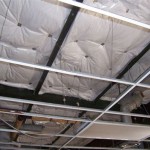Why Do Old Houses Have Tall Ceilings?
When you walk into an old house, one of the first things you'll notice is the high ceilings. They give the house a sense of grandeur and spaciousness. But why are old houses built with such tall ceilings? There are several reasons.
1. Cooling
Before air conditioning, homes relied on natural ventilation to cool themselves down. The warm air rises, so tall ceilings allow the hot air to escape from the house. This creates a more comfortable living environment during the hot summer months.
2. Heating
Tall ceilings also help to heat the house in the winter. The warm air rises and collects near the ceiling. This means that the heat is distributed evenly throughout the house, creating a more comfortable living environment.
3. Status symbol
In the past, tall ceilings were seen as a status symbol. Only wealthy people could afford to build homes with high ceilings. This is because it required more materials and more labor to build a house with tall ceilings.
4. Architectural style
The architectural style of a house can also influence the height of the ceilings. For example, Victorian homes often have high ceilings. This is because the Victorian era was a time of great architectural innovation, and many architects were experimenting with new ways to build homes.
5. Practicality
Finally, tall ceilings can also be practical. They can provide more space for storage, and they can make a room feel larger than it actually is. This can be beneficial in small homes.
Today, tall ceilings are no longer just a luxury. They can provide a number of benefits, including improved cooling, heating, and ventilation. If you're looking for a home with a unique and stylish look, a home with tall ceilings is a great option.
Why Do Many Old Buildings Have Tall Ceilings If They Were Former Factories Converted To Condos I Understand But What About Houses Was This A Sign Of Wealth Quora

High Ceilings In Old Houses Looking For Documentation Page 2 The Historic District

Why Do Old Houses Have Tall Ceilings Solved
Why Are House Ceilings So Low In England Quora

Why Do Old Houses Have High Ceilings Village Cottage

How To Take Advantage Of High Ceilings In Renovations Archdaily

The Ultimate Guide To Vaulted Ceilings Pros Cons And Inspiration
Why Are House Ceilings So Low In England Quora

Classic Or Craze High Ceilings St Louis Homes Lifestyles

How To Take Advantage Of High Ceilings In Renovations Archdaily
Related Posts








